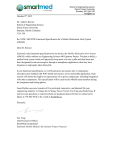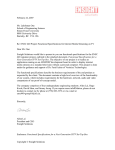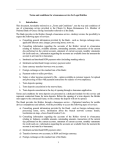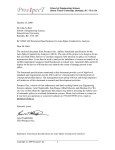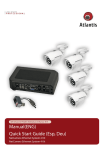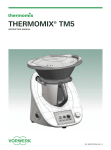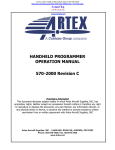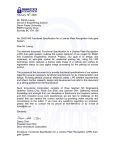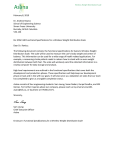Download DualCoolerRefrigeration System - Not Found
Transcript
DualCooler Refrigeration System A more environmentally friendly Refrigeration System Post Mortem Project Team: Ranjita Ravi Allan Vincent Gonsakar Gunasingam Abantika Oishee Hasan Syed Contact Person: Ranjita Ravi ([email protected]) Submitted To: Dr. Andrew Rawicz Steve Whitmore School of Engineering Science Simon Fraser University Issued Date: April 25, 2014 Post Mortem for the DualCooler Table of Contents Table of Contents ........................................................................................................................................... i List of Figures ................................................................................................................................................ ii Introduction .................................................................................................................................................. 1 Overview ....................................................................................................................................................... 1 Challenges ..................................................................................................................................................... 5 Group Dynamics ............................................................................................................................................ 6 Reflections .................................................................................................................................................... 7 Hasan Syed ................................................................................................................................................ 7 Contributions: ....................................................................................................................................... 8 Ranjita Ravi ............................................................................................................................................... 8 Contributions: ....................................................................................................................................... 9 Gonsakar Gunasingam .............................................................................................................................. 9 Abantika Oishee ...................................................................................................................................... 10 Allan Vincent ........................................................................................................................................... 11 Work Breakdown .................................................................................................................................... 12 Conclusion ................................................................................................................................................... 12 Appendix: Meeting Agendas ....................................................................................................................... 13 Meeting: January 6th 2014 ...................................................................................................................... 13 Meeting: January 13th 2014 .................................................................................................................... 14 Meeting: January 17th 2014 ................................................................................................................... 15 Meeting: February 9th 2014 .................................................................................................................... 17 Meeting: February 11th 2014 .................................................................................................................. 19 Meeting: March 6th 2014 ....................................................................................................................... 20 Meeting: March 26th ............................................................................................................................... 20 Copyright © 2014 RefriECO i|Page Post Mortem for the DualCooler List of Figures Figure 1 - System components being controlled by the microcontroller……………………………………………….3 Figure 2 - Expected vs Actual Cost of our refrigeration system……………………………………………………………..4 Figure 3 – Estimated vs. Actual deadlines for each phase of the project……………………………………………….5 Copyright © 2014 RefriECO ii | P a g e Post Mortem for the DualCooler Introduction As it stands today, approximately 18% of our power consumption at home is due to refrigerators and freezers [1]. Our goal for this project was to find a solution and an alternative way to cool the refrigerator. In colder regions of the world we could use the colder air temperature to cool the inside of refrigerator without the use of the compressor. Originally, this project started by comparing two different solutions for utilizing the cold air. One which would use tubes of water that are run around the radiator coils that would act as a heat transfer mechanism much like liquid cooled PCs. The second idea, and the idea we implemented during our demonstration was the solution that we would directly blow the cold air into the fridge when the air outside is cold enough. We would have to use a system of ducts, dampers, temperature sensors and fans. This is the product we designed called the DualCooler by RefriECO. When the weather is cold enough, the compressor completely switches off and RefriECO mode switches on and uses the dampers and fans to control the internal fridge temperature. The designs that were implemented in the DualCooler were inspired by three other technologies such as geothermal energy heating/cooling systems, HVAC central air conditioning systems and Natural lighting – light pipes. Overview The RefriECO DualCooler refrigeration system includes a variety of devices to allow effective functioning of the system. Software plays a significant role in controlling all of the required devices, using the Arduino microcontroller. Arduino Microcontroller The Arduino microcontroller is the heart of the refrigeration system as it provides all of the functionality to control the required devices for the system. The microcontroller is supplied a 12V stable voltage, using an 18V 1A power adapter and a 12 volt voltage regulator. Servo Motors The servo motors are in charge of controlling the opening and closing of both the supply and exhaust dampers. Copyright © 2014 RefriECO 1|Page Post Mortem for the DualCooler Fans The supply fan is in charge of bringing the cold air from the outside to the interior of the refrigerator. The exhaust fans are used to push out the hot air inside the refrigerator. Ducts The supply duct used for the refrigeration system is made using galvanized sheet metal, which makes it easier to put the insulation foam over the outer shell of the duct. The insulation is essential to maintain the air flowing through the ducts at a stable temperature. The exhaust duct, on the other hand, is used to transport the hot air from the inside of the refrigerator, and is made of flexible galvanized metal to allow the duct to turn as required by the shape of the house. Temperature sensors The outside temperature sensor used in the system is a waterproof digital temperature sensor, which can withstand harsh and wet weather conditions. The inside temperature sensor used is a regular digital sensor which reads the temperature inside the refrigerator. LCD The LCD module was implemented into the system to give the user the current status of all of the temperatures in the refrigeration system. The user can change the temperature units between Celsius and Fahrenheit, as well as set and change the required temperature inside the refrigerator. Compressor The relay is used to control the compressor depending on the conditions when the compressor needs to turn on or off. The basic conceptual design of the refrigeration system is to use the outside air to cool the inside of the refrigerator. This is achieved by turning the fans on, and turning the servo motors, which control the dampers, to open to the required position with the use of the turning joint. When the temperature set by the user is greater than the outside temperature, and less than the temperature inside the refrigerator, then the system turns on to help bring the refrigerator temperature down to the set temperature. When the desired user temperature is met, all of the system components, i.e. the fans, dampers etc. automatically turn off. If both the outside temperature and the internal refrigerator temperature are greater than the temperature set by the user, the compressor turns on, and the rest of the system components turn off. For all other scenarios, no change is made to the system and all of the components in the refrigerator stays off/closed. Copyright © 2014 RefriECO 2|Page Post Mortem for the DualCooler Figure 4 - System components being controlled by the microcontroller The above Figure shows how the microcontroller controls all of the system devices together. The shaded boxes for Pressure Sensors and Air Flow Sensors have not been implemented for the current design of our system but could be added in the future development of the product. Materials, Costs The expected and actual costs of all materials and components are summarized in Figure 2. The significant difference between the expected and the actual costs were due to a few failure of components and additions of new design into the system. The compressor of the initial mini fridge we bought had failed during the first month which required us to buy another fridge of the similar model as we were familiar with the internal structures of the initial fridge. The addition of LCD and PCB design further increased the total cost of the system. Energy meter was also bought in order to measure the total energy savings between the fridge running with the compressor and the fridge running on our modified refrigeration system. Copyright © 2014 RefriECO 3|Page Post Mortem for the DualCooler Figure 5 - Expected vs Actual Cost of our refrigeration system Schedules Figure 3 below shows our estimated and actual deadlines for each phase of the project. It can be seen that the initial research phase on the entire refrigeration process and the ways in order to save energy took much longer than expected. The integration, testing and debugging phases also took longer than expected. Copyright © 2014 RefriECO 4|Page Post Mortem for the DualCooler Figure 6 – Estimated vs. Actual deadlines for each phase of the project Challenges There were quite a few challenges that we have encountered over the duration of the project, however, it has been equally fulfilling to get to the root of the problems and resolving them. Refrigerator: The first fridge that we got was damaged due to mishandling on our part while testing the compressor. Instead of simply discarding the fridge, we have made use of it for preliminary testing and measurement purposes, which enabled us to be more precise on the second refrigerator. Also, while defragmenting the first fridge, we accidentally cut off the heating coil which was installed within the metal piece. This made us aware of the three layers that are typically present on a fridge, so the next time around, we made sure that we cut the plastic layer first, then the insulation and then the metal, in order to avoid that from happening. Servos: The support for the servo motors wasn’t very sturdy, and it was a bit tricky to get the placement right. After several trials at positioning the servos, we finally managed to get the proper orientation. Power: We had to implement an external power supply to manage the circuit, and we needed something that will be wall mounted and a stand-alone system. After some group discussion as well as Copyright © 2014 RefriECO 5|Page Post Mortem for the DualCooler consultation with the TA, we decided to use voltage regulators to maintain a constant voltage level across the circuit. The next challenge was to get the required voltages delivered across the microcontrollers and the fans. Since, USB power wouldn’t suffice our purpose, we decided on 18V power adapter to be connected to the circuit board using power jack. Fans: We ran into problems with the fan while trying to place the bucket of ice to the system for the testing/demo purposes. The wire from the fan got warped into the edges of the bucket, which required us to cut the wires and re-solder them, and shielding them with a heat shrink to avoid any further scrape-off. Ordering parts: Initially, we were planning to get most parts online at a cheaper rate, but due to some unforeseen shipping problems, we kept getting delayed. Hence, we decided to just buy them locally instead of taking any chances, which we found was more effective in terms of getting an idea of all the parts that we could be using. Group Dynamics RefriEco has been through an interesting journey over the course of last four months, with everyone collectively following the motto "Never lose humour under any circumstance". While there has been difference in opinions, quite naturally, considering that each of us shared different viewpoints, we still managed to fairly work well together. The work load was assigned based on the attributes of the team members, while making sure that we allowed each other the space and creative liberty. Our product and the design of our system required us to have the following skills: 1. Hardware skills to design and construct the physical components of the fridge. 2. Software skills for interacting with the Arduino and developing the code to retrieve data from the sensors 3. Basic knowledge of thermodynamics 4. Trouble shooting and debugging errors The responsibilities have mostly been evenly distributed and whatever conflicts arose, were amiably discussed and resolved. Since all the members were involved in most aspects of the project, it was easier to identify an error and resolve it, with the assistance from a fellow member. Copyright © 2014 RefriECO 6|Page Post Mortem for the DualCooler Reflections Hasan Syed One of the main problems that held the group back was the failure of the first fridge. While having this failure, our group was quite reluctant to get the new fridge. Without the new fridge, our technical progress was held back since no testing or discussion could be held in regards to the circuitry of fridge compressor. Another reason for the delay of compressor testing was the price and replacement costs. Since the second fridge cost about $100, having to attempt and the fear of burning one of the circuit components would have major setbacks to the project. On top of the cost and time issues, another problem was that none of the group members have previous experience in designing the circuitry of high voltage appliances. Coming over the fear of high voltage circuitry was a major learning for members of the group. Our circuit design consisted of several new components that we had never used before. These new components included the Arduino microcontroller, voltage regulator, fridge compressor and more. Having to maintain proper voltages and ensure the current limit from power supplies was one of the major things I took away from the course. This learning will last with me for a long time since one of the mistakes cost us the microcontroller. Having to figure out this problem was quite time consuming and painful. The current would overload in the microcontroller and would cause it to restart if you tell it to move to a certain location that wasn’t possible. Since we had to apply enough minimum pressure to seal and the damper gates, the microcontroller would restart if the orientation of the servo motors was lost. It required quite a bit of head scratching and consulting pears to figure out the problem. In the end, the servo motors worked completely fine by maintaining the seal and never having to restart the microcontroller again. Our group had some communication problems when designing the PCB or the prototyping board. Once I had completed designing the circuit on a program called Fritzing, I was continuously told to do the design over again on Eagle and found it to be a complete waste of effort, since I would have to learn the program from scratch and it would do the exact same thing. Initially, I was told to do the circuit on the prototyping board. I disagreed with this idea from the start since we had tested the circuit out on the beard board and knew that everything worked fine. Regardless, once finished the wiring layout on the prototyping board, all the wiring was redone by some members for unknown reasons, as the board did the exact same thing as it did when I made it. Once we had completed the prototyping of the board, we decided to do it on the PCB as I had initially suggested. The PCB had the exact same circuit as the one used for the prototyping method and took much less time. All these disagreements were quite exhausting and caused us to use double the amount of time as it should have to complete the circuitry Copyright © 2014 RefriECO 7|Page Post Mortem for the DualCooler of the project. Working with group members can be quite challenging but in the end you learn to work together. Contributions: One of the solutions to the proposed project problem (idea1 that would use water pipes to exchange temperatures, which wouldn’t require holes inside the fridge). Research and selection of parts and ordering online/fetching from the store Initialize PCB circuit layout and update the diagrams as the changes were occurring Trouble shooting of the circuit on breadboard and came up with test cases to make sure proper operation would be maintained Drilling of the main PCB and soldering of wires and components and etching of the second/backup of the final PCB Devised the mechanical opening and closing structure of the dampers Wiring layout to properly and safely route the wires to the central circuit LCD cover failed twice so we gave up on it. First one fail because to improper material used. The second one failed because the screen shattered near the completion Proper cooling and maintaining of the ice to simulate the cold temperature for the demo Ranjita Ravi I’d like to start off by saying I’ve known Hasan, Niroshan and Allan for the last 5 years and Oishee for the last 4; years through which we’ve all gone through a journey and changed over time. ENSC440/305 was just the epitome of our journey together through Engineering at SFU and an experience I will never forget. I’ve been lab partners with them previously and believed we would be great to work together for this project. Indeed our relentless sense of humour may help in relieving the stress that this course brings through no fault of its own (which could also hinder if not controlled). As the elected CEO I was thrilled to bring in my leadership from being WEG President to this group. I had every intention of keeping it organized, organizing meetings, taking notes, breaking reports down for my team members to draw upon. For the most part we all had a system and understanding going and our group was notorious in the lab for being a little too light hearted. In the background we had been doing a lot of work. However, I realised, that no matter how much planning, time management or scheduling you do, there is no perfect development cycle. Life always has a way of throwing curve balls. One of the things I wish I’d done more of is official minutes. Parts were delayed, parts didn’t function at crucial moments and nothing was ever guaranteed although you thought it was done. Furthermore, 440/305 pushes the boundaries of friendships. There were times when I believed some of us would no longer be as close as we were. But you learn to work together and get over these obstacles, and when the job is done all is forgiven. Copyright © 2014 RefriECO 8|Page Post Mortem for the DualCooler On a more technical note, it has yet again been proven to me that applying concepts is really the best way to learn concepts. Labs in designated engineering courses are one thing and actually coming up with the idea to use the concepts instead of a lab manual with instructions is another. For example, there was a time in our project where we could not get our fan to stop. Apparently the current was not low enough to make it stop completely. After a night of pondering over it we realised we would use BJTs or MOSFETs. When we actually applied the concepts and it worked we were elated. I don’t think we’ll forget how a BJT works anytime soon. Also this particular project, pushed us to learn about new engineering disciplines such as fluid dynamics and thermodynamics. All in all this was a great hands on engineering experience, albeit a tiring one. Contributions: - Team lead - Meeting minutes documentation - Work breakdown - Module level programming - Circuit integration (including power source challenge contributor) - Documentation integration and editing - Shopping for parts - Research - Prototype board soldering - PCB design Gonsakar Gunasingam It has been a wonderful experience for me having a chance to work with a group of talented Engineers who have a strong passion towards various areas of technologies like computers, electrical and control systems. In this past 4 months, I have gained an unforgettable learning experience such as communication skills, time management skills, organizing skills, writing skills and team work skills. Throughout this project, however, my team and I had encountered a lot of challenges and overcome all the hurdles and made our RefriECO dual cooling system to work as we expected. First foremost, we have simply spent almost half of the semester learning about how a regular refrigeration system works and the thermo dynamic application behind it. Once we figured out the cooling cycle system and it functionality then we moved on to see how we could control the compressor cycle by using a controller. At the beginning it was challenging to keep up with all the deadlines and the reports that we had to write explaining our functionality of the system but eventually we got back to the top of our development cycle, and meet all the deadlines, which all seemed impossible to achieve. Fortunately, we were able to meet the deadlines, and complete all the newly proposed functionality of our prototype, but looking back at a time when we made such a decision, every single one of us were in Copyright © 2014 RefriECO 9|Page Post Mortem for the DualCooler a panic due to a limited time given to us with all the other course material throughout the semester. I strongly believe my time management skill gradually increased throughout the semester. Our project heavily utilizes Arduino microcontrollers. I had never used an Arduino before, and this project gave me this great opportunity to finally learn about Arduino, utilizing most of the functionality of the Arduino. I finally realize Arduinos are very easy and powerful platform, and will continue to utilize them on my future projects if possible and I bought myself an Arduino Uno starter kit as a first step. I have learnt about how a PCB design (Printed Circuit Board) works and how the wiring for the circuitry works and how to do all the connections to the board. Our project was demanding a fair lot of mechanical elements such as making a hole in the fridge to connect the ducts, making a controlling arm to control the dampers, cover for the LCD screen with buttons. We worked really hard on the mechanical portion of this project we put a lot of time into the initial design and this allowed us to finish the hardware design successfully. As a CTO of the company, the task of making the design was given to me which allowed me to use and learn all the functionality of some power tools like various drills, Jig saw, utility knives and saws as well. I enjoyed my part of making holes and also used my creativity skills to make a design a cover for the Arduino board and the LCD screen. I believe skills will come handy when we were trying to work in an actual working environment as an Engineer in the future and also such skills will only be learnt through the experience of the use of the tools. Last but not least, I would like to thank the professors and TA’s who guided us through this project and giving us some valuable suggestions. It was a really tremendous experience working with such an enthusiastic team and getting the project to work as we expected in the given period of time. Abantika Oishee From an overall perspective, the past four months have been nothing short of a fascinating learning process throughout. I proceeded into this semester knowing that I will be undertaking one of the most crucial courses in my engineering career, but given the opportunity to work with such a creative group of engineers, where it’s like a coming together of ideas, has only made the experience more memorable. My documentation skills have improved vastly, which is very important when attempting to communicate the specifications in writing. I haven’t been exposed to Arduino before, so it has been very fulfilling to work with an open source platform as such. It has also made me aware of how much I have to work on my time management skills before I can successfully handle a project from the scratch to finish. I did learn quite a bit about PCB design and looking forward to enhance this skill further in my other projects. Copyright © 2014 RefriECO 10 | P a g e Post Mortem for the DualCooler As the CFO of the company, my primary responsibility was to manage the financial section and keep track of all the documentation. My experience as a Financial Officer in IEEE, Vancouver Branch, has helped me in serving my role. In a nutshell, I would cherish these memories with me and take all that I have learned with me. I am grateful to my team members for bringing together such a successful project. Allan Vincent During the course of this project, I had the wonderful opportunity to expand both my technical and nontechnical skills. Working with a highly skilled and enthusiastic group of engineers was very motivating and inspiring. We shared knowledge and assisted one another throughout all challenges and hurdles that this projected presented; and finally succeeded in completing and delivering a great product. I gained invaluable experience in working and collaborating in a team; and got a glimpse of how teams work in the real world. Our team, like any other, had to overcome conflicts and differences of opinions, and this not only helped me learn the value of effective communication and healthy discussions, but also taught me to have mutual respect for others and their ideas. I improved verbal and written communication skills, and got a valuable practice in effectively communicating my ideas across. The documents required in various stages of the project helped me learn how to write reports and formal documents. This project heavily demanded time, effort and detail planning, which helped me improve my time management and organization skills. Perhaps one of the most important takeaways I have from this project is the development of my research skills. As the CIO of the RefriECO Company, one of my primary responsibilities was researching technical specifications, such as the working of all the hardware components, software technologies, etc. A major part of this task involved researching and understanding the libraries used and required by the various devices, and the API functions they provide, and using them to implement the functionality needed of the devices. Besides the above interpersonal skills, I acquired a significant amount of technical expertise in various areas. One of my biggest challenges and also perhaps my biggest accomplishment was learning the Arduino programming language and understanding the Arduino microcontroller. Designing an embedded system, with all the hardware components – fans, servo motors, temperature sensors, LCD display, relay etc. – controlled by, and intercommunicating through, the Arduino was a valuable exercise. Working with my team and the TA on designing the printed circuit board and etching the board using copper and fiber materials was a great learning experience. Soldering pins and wires on the PCB helped me enhance precision with a solder and soldering iron. Copyright © 2014 RefriECO 11 | P a g e Post Mortem for the DualCooler Knowledge of all the internal processes that take place in a refrigerator, including the workings of all its components, and all details of the cooling cycle which involves compression, condensation and evaporation stages, has given a significant boost to my theoretical knowledge. Work Breakdown High-Level Task Documentation Documentation planning Documentation Editing Mechanical Engineering (includes duct work, wiring, servo mounting, LCD mounting etc) Packaging Circuit Design PCB Design PCB Printing Arduino Software Implementation Testing Administrative Tasks Shopping for parts x = some or equal responsibility xx = Primary responsibility Ranjita x xx xx xx xx x x x x Hasan x x x xx x x x x x x x Abantika x x x xx x x x x x x Gonsakar x x x xx Allan x X xx x x X xx x x xx X xx x Note: Mechanical engineering includes all the work done on the fridge such as duct work, wiring, enclosure, servo mounting, LCD mounting etc Conclusion RefriECO has successfully managed to deliver a sustainable and eco-friendly ultra-efficient refrigerator and has met most of the functional and design requirements. We have had great coordination as a group and have managed to abide by the timeline and the personal deadlines that we have set for ourselves. We do believe that this project could be implemented in a grand scale, and given the time and opportunity, we would modify and licence the product in the market at a later stage. Copyright © 2014 RefriECO 12 | P a g e Post Mortem for the DualCooler Appendix: Meeting Agendas Meeting: January 6th 2014 Note: Numbering is random and has nothing to do with the popularity of the project Wind Energy Kites (Hasan) Background: ● ● ● based on this TED talk: http://www.youtube.com/watch?v=LguEk06Wb-U as the kite flies or tugs at the string, the string in turn pulls on a generator that generates power control the power generated by adjusting the resistance of the kite by manipulating the wings or direction of the kite; helps with bringing the kite back down too ○ increase to generate power as the kite flies higher ○ decrease the resistance to pull the kite back Feasibility: ● ● ● can demonstrate concept using a small generator and a remote controlled plane(can control resistance) if we can make it work with a plane, then try it with a custom made plane/kite disadvantage: we’d have to try this out and we’re not even sure if it will work. can we do it all in 4 months?? Efficient Refrigerator (Allan and Niroshan) Background: ● ● ● ● channel the cold from outside via a duct to keep contents of the fridge cold without the use of built-in cooling systems when not required especially useful for places where winter temperatures can reach below -4°C (temperature inside a fridge on average) similar idea as geothermal heating in households can use a damper to regulate the temperature Copyright © 2014 RefriECO 13 | P a g e Post Mortem for the DualCooler Feasibility: ● ● ● ● it has been done before and so it is not impossible talk to andrew to see if any enhancements can be made requires microcontrollers (arduino boards with temperature sensors as add-ons), a duct, dampers and mini fridge Disadvantage: Hasan thinks its not original enough Noise Suppressor (Vacuums) (Oishee) ● ● use sensors to detect excess noise reduce the noise somehow ○ most likely noise cancelling or noise “aliasing” techniques such as the technology embedded in headphones Ranjita is backing the Canadian Refrigerator idea :). Her own ideas are too computer based and may not be suitable for a group that is a wonderful mix of systems, computers and electronics engineers. Meeting: January 13th 2014 Things to do: Hasan/Allan ● ● ● ● Research the tube cooling system similar to the pc water cooling systems check the energy consumption ○ how much energy the radiator for the system uses look into the cost of the system as well List all the parts required and the cost of the parts ○ maybe look into which liquids work best(ie. distilled water over normal water) Niroshan/Oishee ● Air cooling system costs Copyright © 2014 RefriECO 14 | P a g e Post Mortem for the ● ● DualCooler Estimated Energy Consumption parts required for it Ranjita ● ● ● normal fridge energy consumption ○ part by part(ie. compressor, fan, lights…) how to make it work manuals and parts descriptions Other things to do: ● start looking into what needs to be done for the proposal Meeting: January 17th 2014 Report Components and Breakdown Keep in mind, we need: ● ● ● A logo A company name A product name Report: ● ● ● Proposal Letter (Ranjita) ○ the CEO signed letter ○ Done Title Page (Ranjita) ○ names and positions ○ submitted to ○ date submitted Executive summary (Hasan) ○ similar to abstract, but more informal ■ refer to powerpoint (slide 11): http://www2.ensc.sfu.ca/~whitmore/courses/ensc305/pdf%20files/Proposals_a nd_Progress_Reports.pdf Copyright © 2014 RefriECO 15 | P a g e Post Mortem for the ● ● ● ● ● ● ● ● DualCooler Table of Contents ○ including list of figures and glossary Introduction (Niroshan) ○ whats the difference between Introduction and Executive summary ○ Almost Complete Explanation of key elements ○ overview of project (Allan) ○ solutions ■ Idea 1: cool air (Niroshan) ● with heat exchanger? ● really awesome filters ● not letting the air go through the inner fridge compartment ■ Idea 2: cooling tubes around condenser (Hasan) ○ possibly have little diagrams/flowcharts for the ideas (Ranjita) ○ energy consumptions for each of the proposed solutions (Oishee +Allan) ○ Market and competition (Oishee + Allan) ■ using them in single homes or apartment buildings/high rises ■ approximate target population ■ payback period of enhanced fridges with savings over power ● would depend on where these people live ○ wide ranging solutions for other types of refrigerators, brands etc Budget (Oishee) ○ costs ■ broken down for each of the solutions ○ funding ■ Wighton, ESSEF, ensc $50 Scheduling and timing (Ranjita) ○ Gantt Charts ○ Milestones Team Bios (All) ○ prepare little schpeals for each of yourselves Conclusion (Hasan Niroshan) ○ the usual References (Hasan) ○ where did we find information Copyright © 2014 RefriECO 16 | P a g e Post Mortem for the DualCooler Final Checks: ● ● ● page numbers copyright things citations Meeting: February 9th 2014 RefriEco Agenda February 9, 2014 12:30 - 1:20 Lab 1 Purpose of Meeting: To discuss any updates and future plans for the project Items for discussion: ● ● ● status of orders? what will our design look like? (detailed drawings) what are the parts of Func. Specs report we can split between us? Copyright © 2014 RefriECO 17 | P a g e Post Mortem for the DualCooler RefriEco Minutes February 9, 2014 12:30 - 1:20 Lab 1 Present: Allan, Niroshan, Oishee, Ranjita Absent: Hasan (was sick) Purpose of meeting: To discuss any updates and future plans for the project Minutes: Ranjita called the meeting to order at 12:30 A. Approval of the agenda and minutes of January 17th 2014 Minutes were approved B. Status of orders? Discussion: We have the fridge and have had issues with temperature sensor orders from Hobbyking.com. Waiting on other parts. Action: Cancel order with HobbyKing and order from Lee’s Electronics C. What will our design look like? Discussion: There is still confusion as to what our fridge will look like. Confusion of ideas and conditions and use of agreed upon parts. Copyright © 2014 RefriECO 18 | P a g e Post Mortem for the DualCooler Action: Draw a detailed diagram and go over every part and placement of part. Als go oever all the settings and conditions. D. What are the parts of the Functional Specs. report we can split between us? Discussion: Divide the parts in a different document and assign people to it. Need to brainstorm some specs. Action: Assigned parts will be attached to these minutes. Will go over the design. E. Next Meeting: Wednesday, February 12, 2014 Meeting Adjourned at 1:30. Meeting: February 11th 2014 In Attendance: Hasan, Allan, Oishee & Ranjita Meeting mostly to discuss the functional specifications report breakdown Introduction (Ranjita) ● scope ● intended audience ● classification of specifications General Requirements: ● Can brainstorm together after meeting Duct Specifications (Niroshan) Damper Specifications (Hasan) Temperature Sensors (Oishee) Microcontroller Requirements (Allan) Filter & Grill Requirements (Ranjita) System Test Plan (Allan & Hasan) Copyright © 2014 RefriECO 19 | P a g e Post Mortem for the DualCooler User Manual (Oishee) Integration (Ranjita & Allan) Notes on Functional Specs: ● Get all the parts done by Thursday that way we can start integrating and proof reading over the weekend Meeting: March 6th 2014 In attendance: Niroshan, Allan, Hasan, Oishee and Ranjita Meeting to discuss what Jamal talked to us about ● ● ● ● although it seemed like we left a bad impression on Jamal, he is a really nice guy and very helpful Oishee and I met him yesterday and discussed the functional specs report as well as future plans ○ he expected a bit more detail in the functional spec reports ○ we could have introduced our sections ○ we could have also added some minor calculations ○ Jamal assured us that if we do better on the design specs he will reconsider out functional specifications mark ○ also talked about future plans with Jamal we need to organize another meeting with Jamal where we can all meet him ○ we need to meet him ASAP as this project really needs to get going Picked meeting time to be: March 7th sometime after 1:30 Meeting Adjourned Meeting: March 26th Roadmap Copyright © 2014 RefriECO 20 | P a g e Post Mortem for the DualCooler Blue stuff, mechanical and fridge related. Green stuff, intehration/finishing stuff. Red stuff, absolute final stuff. Things we did so far: Temperature sensors o Tested individually o Integrated 2 temp sensors o Tested it outside o Temperature sensors are ready to go Fan o Fan works o Data and measurements taken o One fan has been fitted with the fridge Fan and temperature sensors (both) integrated Ducts, one damper, LCD attached onto model fridge Relays tested and working o Tested with fan in place of compressor Most major documentation complete :) o Post mortem report left (10%) Things to be done: LCD programming Servo programming LCD, servo, fan, temp sensors integration PCB design o Design and show Jamal o Utilize voltage regulators Test servos with damper Buy new refrigerator Drill holes and install ducts and damper on new fridge Compressor switch Wiring (use heat shrink tubes) Attaching parts Designing and placing of enclosures and components Printing PCB and soldering on parts Create testing environment o Buy cooler and drill holes o Figure out if we need ice or dry ice or something else TESTING, TESTING, TESTING AND DATA ACQUISITION Copyright © 2014 RefriECO 21 | P a g e Post Mortem for the DualCooler Prepare presentation Prepare post mortem documentation Copyright © 2014 RefriECO 22 | P a g e


























